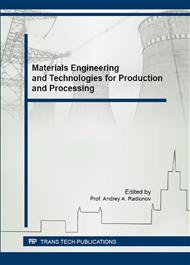[1]
S. Odenbach, Colloidal Magnetic Fluids: Basics, Development and Application of Ferrofluids, Lect. Notes Phys. 763 , Springer, Berlin, (2009).
Google Scholar
[2]
A. Joseph, S. Mathew, Ferrofluids: synthetic strategies, stabilization, physicochemical features, charac-terization, and applications, Chem. Plus. Chem. 79 (2014) 1382-1420.
DOI: 10.1002/cplu.201402202
Google Scholar
[3]
R. Kaur, A. Hasan, Synthesis and surface engineering of magnetic nanoparticles for environ-mental cleanup and pesticide residue analysis: a review, J. Separation Sci. 37 (2014) 1805-1825.
DOI: 10.1002/jssc.201400256
Google Scholar
[4]
L. Vekas, M.V. Avdeev, D. Bica, Magnetic nanofluids: synthesis and structure, in: Nanoscience in Biomedicine, Springer, Berlin, (2009).
Google Scholar
[5]
M. Faraji, Y. Yamini, M. Rezaee, Magnetic nanoparticles: synthesis, stabilization, functionalization, characterization, and applications, J. Iranian Chemical Society. 7 (2010) 1-37.
DOI: 10.1007/bf03245856
Google Scholar
[6]
S. Laurent, S. Dutz, U.O. Hafeli, M. Mahmoudi, Magnetic fluid hyperthermia: focus on superpara-magnetic iron oxide nanoparticles, Advances in Colloid and Interface Sci. 166 (2011) 8-23.
DOI: 10.1016/j.cis.2011.04.003
Google Scholar
[7]
M. Mahmoudi, S. Sant, B. Wang, S. Laurent, T. Senet, Superparamagnetic iron oxide nanoparticles (SPIONs): development, surface modification and applications in chemotherapy, Advanced drug delivery reviews. 63 (2011) 24-46.
DOI: 10.1016/j.addr.2010.05.006
Google Scholar
[8]
I. Sharifi, H. Shokrollahi, S. Amiri, Ferrite-based magnetic nanofluids used in hyperthermia applications, J. Magnetism and Magnetic Materials. 324 (2012) 903-915.
DOI: 10.1016/j.jmmm.2011.10.017
Google Scholar
[9]
W. Kratschmer, L.D. Lamb, K. Fostiopoulos, D.R. Hoffman, Solid C-60 – a new form of carbon, Nature. 347 (1990) 354-358.
Google Scholar
[10]
C.S. Yannoni, M. Hoinkis, M.S. de Vries, Scandium clusters in fullerene cages, Science. 256 (1992) 1191-1192.
DOI: 10.1126/science.256.5060.1191
Google Scholar
[11]
S.A. Majetich, J.O. Artman, M.E. Mchenry, N.T. Nuhfer, S.W. Staley, Preparation and properties of carbon coated magnetic nanoparticles, Phys. Rev. B. 48 (1993) 16845-16848.
DOI: 10.1103/physrevb.48.16845
Google Scholar
[12]
E.M. Brunsman, R. Sutton, E. Bortz, S. Kirkpatrick, K. Midelfort, J. Williams, Magnetic properties of carbon coated, ferromagnetic nanoparticles produced by carbon-arc method. J. Appl. Phys. 75 (1994) 5882-5884.
DOI: 10.1063/1.355548
Google Scholar
[13]
T. Gеgechkori, G. Маmniashvili, E. Kutelia, L. Rukhadze, Technology for production of magnetic carbon nanopowders doped with iron and cobalt nanoclusters. J. Magn. Magn. Mater. 373 (2015) 200–206.
DOI: 10.1016/j.jmmm.2014.05.007
Google Scholar
[14]
S. Chaitoglou, M. Reza Sanaee, N. Aguiló-Aguayo, E. Bertran, Arc-discharge synthesis of iron encapsulated in carbon nanoparticles for biomedical applications. J. Nanomater. (2014) 8.
DOI: 10.1155/2014/178524
Google Scholar
[15]
M. Keidar, I.I. Beilis, Chapter 6-Plasma Nanoscience and Nanotechnology. Plasma Engineering, Academic Press, Boston, (2013).
Google Scholar


